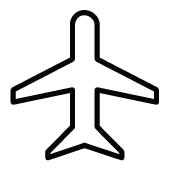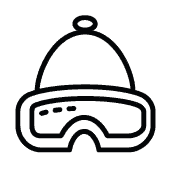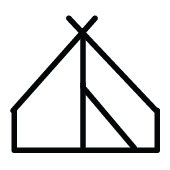Mount Vinson Gear List
Organizing for Antarctic Extremes
Antarctica can feel warm enough for sunbathing, but frequently lives up to it’s more common image as a frozen continent battered by extreme storms and temperatures well below 0°F. For a safe, comfortable, and smooth journey, read this guide thoroughly as it will help you prepare for your trip.
You need four different types of luggage for this trip:
- Expedition Backpack – big, comfortable, and sufficient for carrying gear to high camps when we leave our sleds behind.
- Sled Duffel Bag – the biggest, burliest duffel available. Think 150-liters in size.
- Small Daypack – 15-25 liters in size, this will be used for your flight to the continent. Superlight and foldable daypacks work well for this.
- Small Duffel – useful as a carry-on when traveling to Chile, and useful for storing belongings at the hotel.
How do these four kinds of luggage work together? Read below to understand the trip flow.
 Stage 1 – Travel to Chile
Stage 1 – Travel to Chile
Pack everything (except for a few items mentioned below) into your sled duffel and check it in with your airline. Your expedition pack should be flat-packed inside of the sled duffel.
Pack your small duffel as your carry-on, and remember any usual comfort items for international air travel. Staying relaxed prior to your expedition will contribute to your success on Mount Vinson! Pro tip: we fly with our high-altitude boots and insulated pants in our carry-on baggage. These items are difficult to replace in Punta Arenas.
 Stage 2 – Trip Prep in Punta Arenas
Stage 2 – Trip Prep in Punta Arenas
Windy but temperate during climbing season, Punta Arenas is on the Straits of Magellan. It’s nice to have a small selection of town clothes with you, suitable for walking along the water or tackling any pre-or-post trip travels. After landing at the airport, we complete a thorough gear check and try to finish packing before the next day’s luggage weighing and check-in. Here’s how we pack:
- Small duffel – anything not flying to Antarctica can remain with you for the night. Before flying to Antarctica, you’ll check this in with your hotel and it will be stored until you return.
- Small daypack – pack this small bag with essentials for the flight to Antarctica. Prescription meds, glacier glasses and goggles, a warm hat, gloves and mittens, sunscreen, and your passport.
- “Go” Pile – we make a pile of gear we’ll wear onto our flight to Antarctica: expedition boots or waterproof snow boots (with a pair of socks), softshell pants, baselayer top, and expedition parka.
- We flat-pack our expedition backpack into the bottom of our sled duffel along with every other expedition item. Anything that goes in this duffel will be inaccessible from check-in until our arrival at Union Glacier Camp (UG, for short).
 Stage 3 – Flight Check-In, Briefing, Etc.
Stage 3 – Flight Check-In, Briefing, Etc.
First thing in the morning, we weigh and then turn in our sled duffels to the flight operator. If weather is good, we’re reunited with our gear the next day in Antarctica (“on the ice”, we say). If weather is bad, it is possible our flight to the ice will be delayed. This can mean hours of delay, or can mean days of delay. It is not possible to recover our duffels during this time, so pack carefully!
In our street clothes, we also attend a logistics briefing with the other teams flying to Union Glacier, explore Punta Arenas a bit, and enjoy a final night in civilization.
 Stage 4 – Flight to Union Glacier (UG)
Stage 4 – Flight to Union Glacier (UG)
After turning over our small duffels to hotel storage and settling up for our rooms, we head to the airport and board the plane to Antarctica. We’re dressed for the cold when we get off the plane, wearing: expedition boots/waterproof snow boots, baselayers, softshell pants, and glacier glasses. We carry with us our small daypack with absolute essentials, and typically sling our expedition parkas over our shoulders. It’s important to pack a hat, goggles, and warm handwear in this daypack in case a storm is brewing on arrival.
 Stage 5 – Hop to Vinson Base Camp (VBC)
Stage 5 – Hop to Vinson Base Camp (VBC)
After loading our sled duffels into the Twin Otter bush plane, we hop an hour to Vinson Base Camp. The weather is typically colder and harsher the further into the continent we go, and we likely take this flight with a few more layers on. It’s common to wear a hat, gloves, and our expedition parkas for the short flight to the base of our objective.
 Stage 6 – Climbing the Mountain
Stage 6 – Climbing the Mountain
From VBC onwards, we tow our sled duffels in sleds (up to the fixed lines), which along with our expedition backpacks contain every stitch of equipment and calorie of food we’ll need to safely climb Mount Vinson. We’ll stash our small daypacks in a cache in the snow, as they won’t be of use to us on the upper mountain.
After the climb has concluded, we’ll reverse the process, all the way back to Punta Arenas.
I enjoyed the Vinson expedition immensely. It was well organized, I had excellent guides (that I was familiar with), and the food while on Vinson was great. Both Sam and Lakpa worked well together to lead our team of nine. You could see them consulting with one another to make the best decisions possible. Their […]